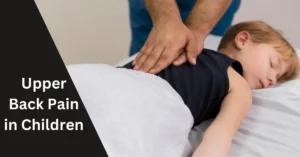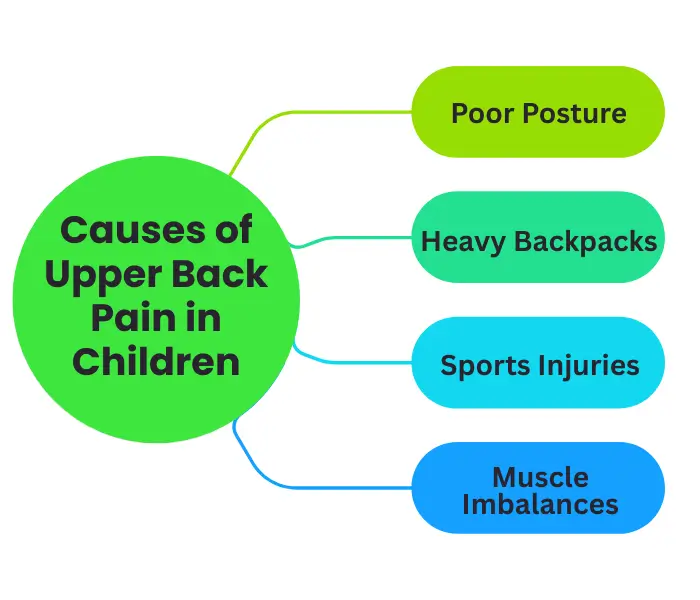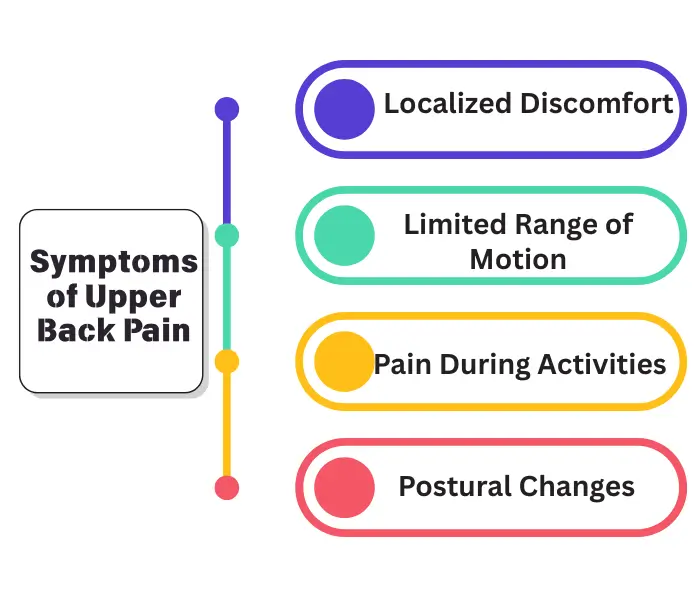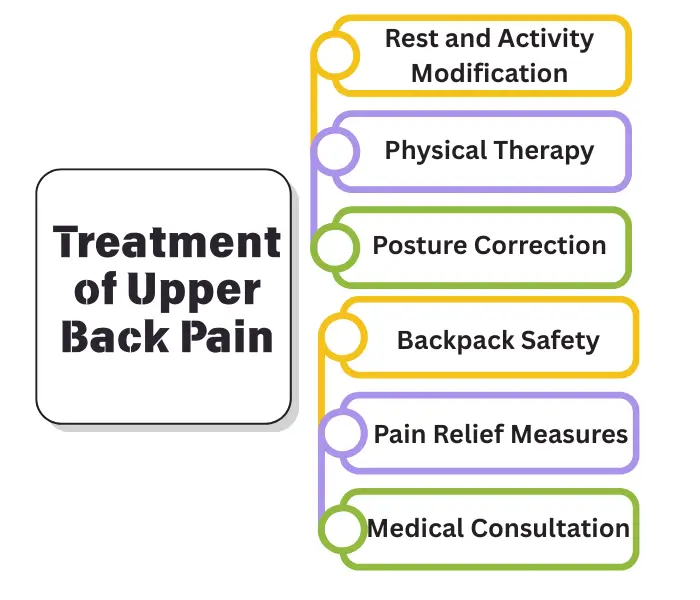Learn how to explore the causes, symptoms, and treatment of upper back pain in children. Understand warning signs, common triggers, and effective care strategies to support your child’s health.
Thank you for reading this post, don't forget to subscribe!Causes, Symptoms & Treatment of Upper Back Pain in Children
When your child complains of upper back pain, it can be both confusing and concerning. Unlike adults, children rarely experience back discomfort, so when they do, it signals something worth attention. From heavy backpacks and poor posture to underlying medical issues, the causes can vary widely. In this guide, we uncover the hidden triggers, telltale symptoms, and proven treatments for upper back pain in children. Early understanding and the right approach can make a lasting difference in your child’s comfort and overall health.
Upper Back Pain in Children
Upper back pain isn’t just a concern for adults; it can also affect children and adolescents. Even though it is easy to dismiss kids’ back pain as growing pains, persistent discomfort can indicate underlying problems. In this blog post, we’ll delve into the causes, symptoms, and treatment options for upper back pain in children, focusing on raising awareness and ensuring the well-being of the younger generation.
Causes of Upper Back Pain in Children
1. Poor Posture
Poor posture is one of the most common culprits behind upper back pain in children. Spending long hours hunched over desks, computers, or smartphones can strain the muscles and ligaments in the upper back, leading to discomfort and pain.
Example: If a child frequently slouches while using their tablet, they might experience upper back pain due to the strain on their muscles and spine.
2. Heavy Backpacks
If children carry large backpacks incorrectly, their backs and shoulders may experience significant strain. This may result in muscle aches, lousy posture, and upper back pain.
Example: A student who consistently carries a backpack overloaded with textbooks might develop upper back pain over time.
3. Sports Injuries
Active children participating in sports are susceptible to injuries that can cause upper back pain. Falls, collisions, and repetitive motions can strain the back muscles and lead to discomfort.
Example: A young gymnast who falls during practice might experience upper back pain due to the impact.
4. Muscle Imbalances
Therefore, muscle imbalances occur when specific muscles are stronger than others, leading to uneven stress distribution on the spine and surrounding structures.
Example: A child who engages in excessive chest exercises without balancing them with back-strengthening activities may develop muscle imbalances and upper back pain.
Symptoms of Upper Back Pain: Decoding Comfort
Children, those bundles of energy and enthusiasm, are not immune to the occasional discomfort. Upper back pain in children can be a bewildering concern, but just like deciphering a treasure map, understanding the symptoms can lead us to practical solutions. Let’s uncover the telltale signs of upper back pain in children and explore ways to guide them toward relief.
1. Localized Discomfort
Imagine a child describing their upper back pain as if pointing to a hidden treasure spot on a map. They might complain of aching or soreness in the upper back region, a sensation akin to discovering a puzzling riddle in their own body.
2. Limited Range of Motion
Suppose a young explorer attempts to look over their shoulder but finds their view obstructed by a tangled thicket. Similarly, upper back pain can limit a child’s ability to move their shoulders and neck comfortably, leaving them feeling like their body’s map is missing key landmarks.
3. Pain During Activities
Consider a young athlete gearing up for a friendly game of soccer, only to wince with each sprint. Upper back pain might appear unexpectedly during activities such as lifting objects or participating in sports, like a cryptic message that surfaces at the most inopportune moments.
4. Postural Changes
Imagine observing a child standing with shoulders slumped forward, resembling a hidden relic seeking the right light. Upper back pain might lead to changes in posture, like rounding of the shoulders, as the body instinctively attempts to navigate discomfort.
Treatment Options: Guiding the Expedition to Relief
1. Rest and Activity Modification
Consider advising a young adventurer to rest and choose gentler trails. Encouraging your child to relax and modify activities that worsen the pain is like offering them a compass to navigate their discomfort.
2. Physical Therapy
Picture a pediatric physical therapist as a seasoned guide, leading your child through exercises that strengthen the muscles supporting the upper back. These exercises act as landmarks that help your child reclaim their comfort and mobility.
3. Posture Correction
Imagine teaching your child the art of treasure hunting—in this case, discovering the treasures of good posture. Educating your child about proper posture and ergonomics, whether sitting at a desk or using electronic devices, is like handing them a map to lifelong back health.
4. Backpack Safety
Visualize a backpack not as a burden but as a trusted companion for a young explorer. Ensuring your child’s backpack is appropriately sized and adjusted and encouraging them to distribute the weight evenly using both straps is like giving them the tools to navigate their journey comfortably.
5. Pain Relief Measures
Consider over-the-counter pain relievers and topical treatments as temporary campfires that provide warmth in times of discomfort. Youngsters should use these instruments under the supervision of adults, just as seasoned explorers do.
6. Medical Consultation
Similarly, imagine seeking the wisdom of an ancient mapmaker who can decipher the landscape. If the pain persists or worsens, consulting a pediatrician or orthopedic specialist for a comprehensive evaluation and personalized treatment plan can be like seeking guidance from a skilled navigator.
Just as adventurers decode maps to uncover treasures, understanding the symptoms of upper back pain in children helps us guide them toward the relief they deserve. By recognizing these signals and providing the proper guidance, we empower our young explorers to navigate the path to comfort and well-being.
FAQs on Upper Back Pain in Children
Q. What causes upper back pain, and treatment?
Upper back pain is often caused by poor posture, muscle strain, or injury. Sitting for long periods, improper lifting techniques, or sleeping in awkward positions can contribute to discomfort. Treatment options include:
- Rest.
- Over-the-counter pain relievers.
- Applying heat or cold to the affected area.
- Gentle stretching exercises.
Physical therapy may also be advised for severe or persistent cases.
Q. How do you treat back pain in children?
Treating back pain in children involves identifying the cause, which could be poor posture, heavy backpacks, or sports injuries. Initial treatments include:
- Encouraging good posture.
- Reducing the weight of backpacks.
- Using ice packs or heat therapy to reduce inflammation.
Physical treatment, stretching exercises, and sometimes prescription drugs are also suggested. See a healthcare professional as soon as possible to ensure the discomfort isn’t coming from a more severe issue.
Q. Why does my child’s upper back hurt?
Upper back pain in children may result from various things, including engaging in physically demanding activities, wearing a heavy backpack, or adopting a bad sitting posture. A curvature of the spine called scoliosis or growth spurts can also cause discomfort. If discomfort intensifies or lingers, seeing a medical professional is critical.
Q. What’s the best way to relieve upper back pain?
The best strategies for treating upper back discomfort are using cold or heat to decrease inflammation, doing mild stretching or strengthening exercises, and correcting posture. Acetaminophen or ibuprofen, two over-the-counter pain medications, can also be beneficial. Physical therapy or massage treatment may offer more relief if tense muscles cause the discomfort.
Q. How to solve back pain?
Solving back pain depends on its cause. Start with simple remedies like rest, heat or cold therapy, and gentle exercises. Strengthening core muscles and maintaining proper posture are essential for long-term relief. Physical therapy, medications, or even surgical intervention may be necessary in more severe cases. Asking a medical expert can assist in adjusting the course of treatment to address the particular source of the discomfort.
Q. Can upper back pain go away?
Yes, upper back pain can go away, especially if minor issues like muscle strain or poor posture cause it. Most instances get better with time and proper care, which includes rest, stretches, and pain management methods. However, persistent or severe pain may require additional medical attention to alleviate it completely.
Conclusion about Upper Back Pain in Children
Finally, children who experience upper back pain should not ignore it because it may affect their well-being. Parents can aid in the relief of their child’s upper back discomfort by comprehending the causes, identifying the symptoms, and putting the proper treatment in place. To maintain a strong upper back and prevent shoulder rounding, encourage nutrient-dense diet choices, easy exercises like cycling, and good riding posture. Please encourage your child to live an active lifestyle while maintaining good posture to protect their backs and general physical health.
However, upper back pain in children should never be ignored or dismissed as a passing discomfort. It’s essential to recognize potential causes, identify symptoms, and take appropriate action to address the issue. By promoting healthy habits and proper posture and seeking professional guidance, we can help ensure that the younger generation grows up with solid, pain-free backs.
Read more articles about Health & Wellness.
You might like to read:
How to Relieve Low Back Pain at Home: 10 Proven Natural Remedies





